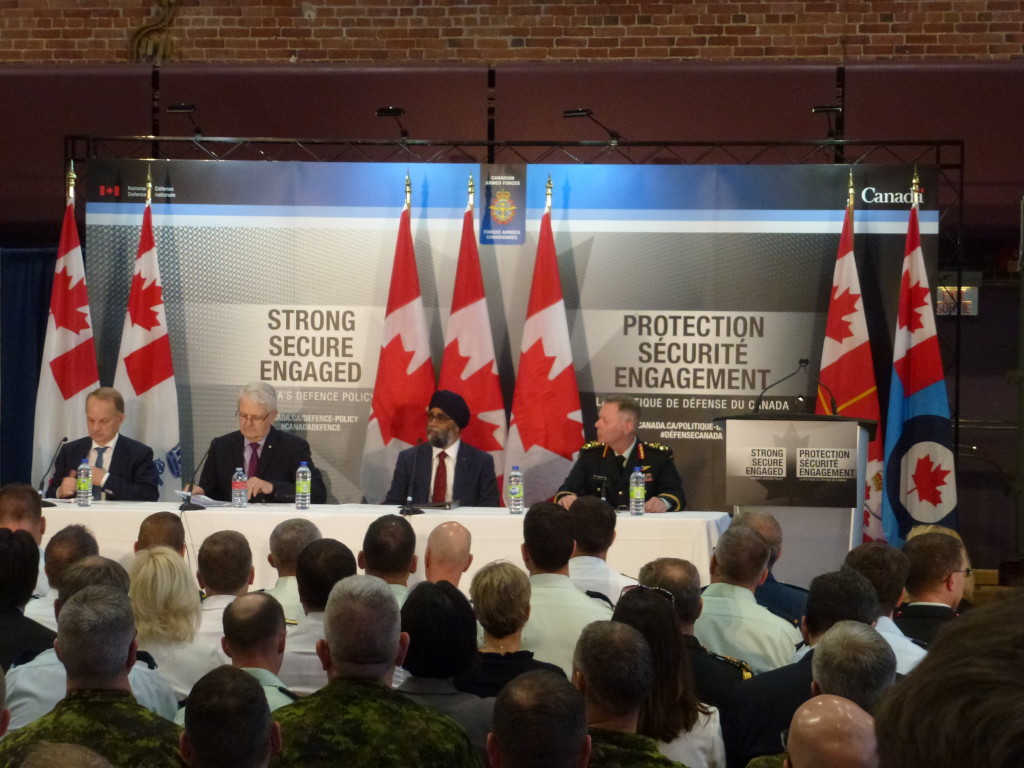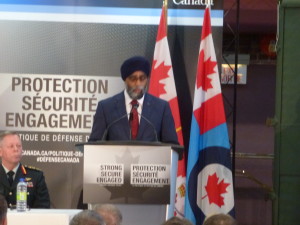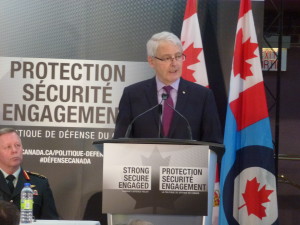
OTTAWA – 1948 mots – Temps de lecture : 2 minutes. On Wednesday morning, members of the press have been invited for a behind closed door session in order to have a first look on the new Canada’s Defence Policy. At 11h00 took place presentations given by a panel of experts from the Department of National Defence (DND) followed by a Questions & Answers session. At 12h50, in front of a few hundred Canadian Armed Forces (CAF) officers from the Canadian Army, the Royal Canadian Navy and the Royal Canadian Air Force, a press conference with Canada’s Defence Minister Harjit S. Sajjan, Transport Minister Marc Garneau and Chief of the Defense Staff Jonathan Vance took place at the Cartier Square Drill Hall in downtown Ottawa.
In a 113-pages document titled ‘Strong, Secure, Engaged’, the government of Liberal Justin Trudeau made public his new defence policy, a long-term defense policy that commits to a range of new investments for the Canadian Armed Forces (CAF), its members, and their families. It needed fourteen months of public and consultations to complete this review process that included open and transparent consultations with Canadians, parliamentarians, defense experts, allies, and partners. On the cost side, The Department of National Defence worked with global defense costing experts from Deloitte, who contributed expertise gained from Defense Reviews in allied nations. DND also partnered with Finance Canada and the Treasury Board Secretariat throughout the costing process to ensure central agency oversight.

Defense Minister Harjit S. Sajjan at Conference on the new Canada’s Defense Policy.
Photo: Philippe Cauchi.

Transport Minister Marc Garneau at Conference on the new Canada’s Defense Policy.
Photo: Philippe Cauchi.
This new Canadian Defense Policy will ensure Canada is:
Strong at home, with a military ready and able to defend its sovereignty, and to assist in times of natural disaster, support search and rescue, or respond to other emergencies;
Secure in North America, active in a renewed defense partnership in NORAD and with the United States; and
Engaged in the world, with Defense doing its part in Canadian contributions to a more stable and peaceful world.
To achieve this, the CAF requires targeted and strategic investment in capabilities and equipment that can be used on domestic and international military operations.
‘Strong, Secure, Engaged’ will renew, replace, and maintain core equipment, and continue to support Canada’s multi-role, combat-ready defense force by:
The new Canada’s Defence Policy pledges to modernize the core fleets of the Army, Navy and Air Force and make new investments in space and cyber capabilities. It also provides for further investment in defence intelligence and communications systems and capacity to better anticipate and react to emerging threats.
To meet the demands of new capability, the Liberal government committed to an increase in the size of the CAF. The Regular Force will grow by 3,500 to 71,000, and the Reserves by 1,500 to 30,000 while the civilian workforce is expected to increase by 1,150.
Under this new policy, annual defence spending will increase from $18.9 billion in 2016/17 to $32.7 billion in 2026/27 on a cash basis ($17.1 billion in 2016/17 to $24.6 billion in 2026/27 on an accrual basis). This policy includes new defence funding of $62.3 billion on a cash basis over 20 years from today’s budget ($48.9 billion on an accrual basis). Of this, $47.2 billion is capital (critical new projects) and $15.1 billion is for operating expenses. Total funding available to Defence over the next 20 years will be $553 billion on a cash basis ($497 billion on an accrual basis).
| 2016-17 | 2017-18 | 2018-19 | 2019-20 | 2020-21 | 2021-22 | 2022-23 | 2023-24 | 2024-25 | 2025-26 | 2026-27 | Total 10yrs | Total 20yrs | |
| Accrual Basis | 17,148 | 17,174 | 17,636 | 18,677 | 19,464 | 20,015 | 20,870 | 22,092 | 23,278 | 23,899 | 24,551 | 207,654 | 497,012 |
| Cash Basis | 18,908 | 20,683 | 21,428 | 21,714 | 24,276 | 25,315 | 26,048 | 29,879 | 31,741 | 31,931 | 32,673 | 265,688 | 553,003 |
In billions Canadian dollars.
*Not including future mission costs
This policy provides $33.8 billion for 52 critical new equipment, infrastructure, and information technology projects on an accrual basis. This equates to $47.2 billion on a cash basis. In total, defence will be provided with $108 billion on an accrual basis for the development and acquisition of capital equipment over the next 20 years.
It also provides $74.2 billion for more than 280 projects already on the books including $26,4 billion for the RCAF, a top-up of $5.9 billion on previous budgets to “better reflect their true costs,” according to the plan. And much of it is intended to be spent in the first 12 years of the policy.
| 20-year Accrual Basis | 20-Year Cash Basis | |||
| Capability | Investments to Fully Fund and Complete Planned Projects (1) |
New Investment Strong, Secure, Engaged (2) |
Total Planned Projects and New Investments | Total Planned Projects and New Investments |
| Royal Canadian Navy | 14.6 | 2.9 | 17.5 | 53.5 |
| Canadian Army | 10.1 | 8.8 | 18.9 | 23.2 |
| Royal Canadian Air Force | 26.4 | 20.1 | 46.4 | 64.4 |
| Special Operations Forces | 1.2 | 0.4 | 1.5 | 1.2 |
| Joint/Emerging Domains | 3.4 | 1.2 | 4.6 | 9.7 |
| Infrastructure | 4.5 | 0.4 | 4.9 | 12.0 |
| Total Capabilities | 60.1 | 33.8 | 93.9 | 164.0 |
| Accrual Expenditure for Existing Equipment and Infrastructure (3) | 14.1 | – | 14.1 | – |
| 20-Year Total | 74.2 | 33.8 | 108.0 | 164.0 |
In billions Canadian dollars.
The New Canada’s Defence Policy and he Royal Canadian Air Force.
The document lists the following priorities.:
In addition, the Government continues to explore the potential acquisition of an interim aircraft to supplement the CF-18 fighter aircraft fleet until the completion of the transition to the permanent replacement aircraft. But as mentioned in the press conference, minister Garneau, all talks are now suspended.
The Government will provide $46.4 billion on an accrual basis ($64.4 billion on a cash basis) to fund equipment projects for the Royal Canadian Air Force over the next 20 years. This includes:
This will translate in the following investments
| Multi-Fleet Air Traffic Management Avionics – Ensures aircraft are compliant with new international flight management regulations. | |
| Multi-Role Tanker Transport – Delivers a new Multi-Role Tanker Transport to maintain air-to-air refuel capability beyond 2026. | |
| Medium Range Air-to-Air Missile Sustainment – Replaces the AIM-7P Sparrow missile that is no longer in production and maintains the RCAF Fighter aircraft air-to-air combat capability. | |
| Advanced Short Range Missile – Replaces the current short range missile that has reached obsolescence. | |
| Future Aircrew Training – Delivers a new and cohesive training program that replaces the current Pilot, Air Combat Systems Officer and Airborne Electronic Sensor Operator training systems. This capability will improve the RCAF’s ability to train sufficient numbers of aircrew for various roles. | |
| Fighter Lead-in Training – Provides a critical bridge between pilot training and the commencement of operational fighter training. | |
| CH-149 Cormorant Mid-Life Upgrade – Upgrades CH-149 avionics as the current suite will increasingly restrict the ability to operate in all weather conditions. | |
| Instrument Landing System Replacement – Replaces obsolete precision approach aids at CAF Wings and airfields. | |
| Canadian Multi-Mission Aircraft – Replaces the current CP-140 Aurora Long Range Patrol Aircraft fleet which will reach end of life in 2030. | |
| CC-130J Block 8 Upgrade – Upgrades hardware and software to ensure interoperability with coalition partners, compatibility with civilian airspace requirements, and engineering diagnostic capability. | |
| CC-150 Life Extension – Extends the life of the fleet by balancing the total airframe hours between tanker and transport variants. | |
| CH-146 Griffon Limited Life Extension – This tactical utility helicopter will be revitalized to prolong its service life. These helicopters provide reconnaissance, air mobility (both independently and through armed escort of larger CH-147 Chinook helicopters), and fire support for land forces. They are also a secondary platform for Search and Rescue. | |
| Utility Transport Aircraft – Replaces the CC-138 Twin Otter before it reaches its end of life. This capability supports the defence of Canada including safeguarding Canadian sovereignty by enabling a tactical air mobility capability in the North. | |
| Defence – Enhanced Surveillance from Space Project – This project will replace the RADARSAT Constellation Mission in 2026. It will consist of a constellation of satellites configured with Synthetic Aperture Radar, Automatic Identification System, and other sensors to support of the Defence mission. | |
| Enhanced Satellite Communications Project – Polar – Provides both narrow and wideband voice and data satellite communications at the tactical, operational and strategic levels to provide assured, secure and reliable communications in support of Canadian and international operations in the Arctic. | |
| Surveillance of Space 2 – Follows-on the Sapphire satellite that monitors the trajectory of other satellites and debris in space to determine threats to Canadian and Allied space assets; contributing to the US Space Surveillance Network and strengthening key Allied partnerships. | |
| Tactical Narrowband Satellite – Provides narrowband near-global communications between 65 degrees South and 65 degrees North latitudes to provide assured, secure, and reliable communications in support of Canadian and international operations. |
Regarding the North American Aerospace Defence Command (NORAD) which will turn 60 years old in 2018, Canada will work with the U.S. to modernize, including considering innovative ways to more effectively defend North America against evolving threats.
A key part of modernizing NORAD is the renewal of the North Warning System, will be part of separate future funding decisions and are not included in the estimates in the new Defence Policy.
Diplômé universitaire en histoire, journalisme et relations publiques, en 1993, Philippe Cauchi amorce une carrière de journalisme, analyste et consultant en aérospatiale. En 2013, il fonde avec Daniel Bordeleau, le site d’information aérospatial Info Aéro Québec.
Commentaires